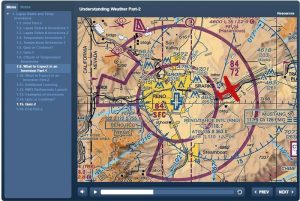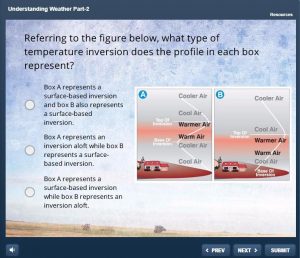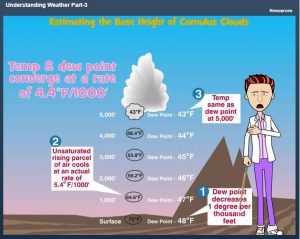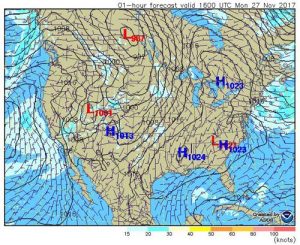We Review Rod Machado’s latest eLearning Course, “Understanding Aviation Weather.”
I don’t know about you, but when I was first studying for the private pilot written exam, it was weather, not navigation or anything else, that I dreaded the most. I clearly remember reading the same page on fronts four or five times without retaining any of it. Now that I passed my written and I’m starting to study aviation weather for practical reasons (like not getting thrown out of the sky by a microburst or rolled over by mountain waves, as well as predicting which days will be good flying days), I figured I needed to find a way to make it all make sense. Besides the fact that there are about 1.3 million types of clouds and seemingly all of them appear here in the high desert every afternoon, there are certain things I simply never learned when studying, like the trade winds and whatnot. In addition to the practical study, I want to get a leg up on my instrument rating before I get my private so I can breeze through it, no pun intended.
Introducing “Understanding Aviation Weather”
Enter Rod Machado, a friend and favorite of Disciples of Flight. As if on cue, I got an email informing me about his latest eLearning module: “Understanding Aviation Weather.” The clouds parted and a beam of light shone down on my laptop, filling me with the hope that one day soon I may be able to decipher all those aviation weather supplements. Naturally, I reached out to Mr. Machado and asked him to hook me up with a copy of his program so that I can review it for all of you wonderful pilots and student pilots out there. A completely altruistic reason that has nothing at all to do with my own wants and needs… I swear.
Anyway, the good Mr. Machado obliged and soon I was starting up the eLearning module in my computer browser. The set-up was the same as the “Handling In-Flight Emergencies” eLearning module I reviewed a while ago: a small video player with navigational tools on the side that show your progress through the course. There’s a play/pause button, skip buttons, all that you’d ever want and need to watch the videos or go back to review them. I expected all this. What I didn’t expect was laughing so hard I actually cried while learning about weather.

Sitting in the lobby of the High Sierra Pilots flying club, I was surrounded by CFIs and student pilots studying charts and debriefing after their morning flights, sharp and focused- until I started laughing hysterically, that is. The animated eLearning module designed and executed by Rod himself is borderline ridiculous at points, but undeniably educational. The first module of the six-part course answered tons of questions I had about atmospheric circulation right off the bat, and even mentioned KRNO, the Reno International Airport, which is cool as it’s right down the street from my house! (Don’t you feel a little bit famous when you see a reference to your town or state in unexpected places?)
A Breakdown of the Understanding Aviation Weather eLearning
The first part concluded with some basics on cloud formation and condensation nuclei, which was a good refresher for pilots and student pilots like me who haven’t opened a textbook in a few months. Part two covered temperature inversions and phenomenon that surrounds them, like limited visibility and wind shear, two things very important to IFR and VFR pilots alike. I particularly liked the section explaining why you can have a smooth-as-butter approach and then get blown off the runway just a few yards above the ground. Beware the shear zone, everyone!
Little Bonuses in “Understanding Aviation Weather”

Another element of this eLearning course I really appreciated and benefited from was the inclusion of real experiments and processes conducted by the National Weather Service and real meteorologists. The video showing how hot and cold fronts interact using colored water spun super-fast on a specially designed piece of equipment was particularly educational, fun to watch, and actually quite helpful when it comes to visualizing the process in a practical manner.
At the end of each module (and occasionally one or two in the middle) are optional, challenging quizzes recapping and extrapolating the material covered in the videos. I definitely recommend taking each one! You may think you absorbed the material, but I feel that knowledge is never locked into place until tested.
Back to the Break Down: “Understanding Aviation Weather”
The third module covered everything you could ever wish to know on atmospheric stability and directions on an experiment you can conduct at home (or anywhere you feel comfortable spitting on your hand – yes, really!) that demonstrates the effects of latent heat. I waited ‘til nobody was looking, and then I tried it. It was actually pretty cool! One of the final topics covered in this module was how to estimate cloud bases, something I admittedly never even tried to learn when studying for the written. (I hope none of my CFIs read this…) Using a little cartoon character that dressed like Ryan Seacrest, Rod Machado explained in an unintimidating manner how to use the environmental lapse rate and your knowledge of dew point to divine the cloud base wherever you know the temperature and dew point on the ground.
Do you ever hear pilots around the airfield discussing lows and highs, and sort of just nod along without really understanding what they’re talking about? No? Just me? Well… anyway, module four of “Understanding Aviation Weather” made everything very clear.
Using animated drawings, images and videos from NASA, and Rod’s one-of-a-kind sense of humor, I can now be the pilot knowledgeably discussing weather phenomena in terms of atmospheric pressure. Not gonna lie, that feather in my cap feels awfully nice.
Part five was particularly valuable to me as a pilot flying in and around the Sierra Nevada Mountains. It covered all sorts of storms, including lightning storms and squall line thunderstorms, and discussed in detail the treacherous mountain waves we talk so much about up here.

In addition to explaining why it’s important to understand why and where mountain waves can occur and be incredibly dangerous to pilots, the module also contained some fun information about ancient weather forecasting. According to Machado, the American folklore, “Rainbow in the morning, Shepherd take warning; rainbow toward night, Shepherd’s delight,” holds water. Because rainbows that appear in the evening are toward the west and form because of the moisture left by a storm that’s already past, you can be fairly confident that the next day won’t be stormy. The opposite is true is you see a rainbow to the east in the morning. It’s amazing to me to think that people noticed and recorded this type of thing way before anyone even said the word “meteorology!”
And finally, part six brings advanced weather lessons. Despite being lulled into a sense of security by the jokes and fun animations, when I got to the slides on wave cyclones and shortwave storm formations, I was a little wary, but Rod made it easy to understand! His animations and drawings are incredibly helpful. Luckily for me, this final section had three individual quizzes. I say luckily because there is a lot of information presented in this section, so it was nice to not only break up the videos but to review all the stuff I just learned about icing and adiabatic charts- stuff that would have gone right over my head the day before!
Final Thoughts on “Understanding Aviation Weather” by Rod Machado

This course was a complete blast. There were quite a few times when I was laughing so hard I had to wordlessly drag my coworkers over to watch the clips that cracked me up. Some personal favorites: the pound cake joke in module one, and the bunny rabbit on the hot ground in module two. Some of the jokes are borderline absurd in the best possible way, but there’s no shortage of the classic Rod Machado puns and culturally relevant humor. There are few things pilots enjoy more than jokes at another pilot’s expense, and this course is chock-full of them. I would recommend “Understanding Aviation Weather” to nearly every pilot I know because unless meteorology is a particular interest of yours, the odds are you haven’t been studying your various weather charts since you got your certificate. In fact, I know some pilots who have been flying for about twice as long as I’ve been alive who couldn’t tell me what density altitude is, and definitely not what the adiabatic lapse rate is.
If you’re a student pilot who, like me, stared at the pages of Jeppeson blankly until the drool dripping onto the page woke you from your daze, this course is definitely for you. Machado does the impossible and makes weather fun and interesting, explaining everything from the basics (how clouds form) to advanced weather theory (like how to predict winds for the days after a storm passes). Take my word for it, it feels great to finally be confident in my weather knowledge! Now I too can make informed and semi-pretentious observations about those darn lenticulars ruining my afternoon.
In short, Rod Machado has done it again, and this time covered a topic every pilot all over the world will need to know: the hazards of weather as it relates to aviation.















Leave a Reply